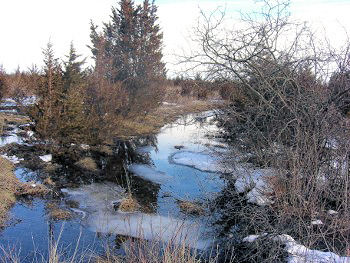Wetlands
A
wetland is defined as an area of land that is saturated with water, either permanently or
seasonally, that takes on the characteristics of a distinct ecosystem. Wetlands are one of the important ecosystems we find within the biodiversity of Canada.
Ontario has four different types of wetland:
Bogs
Bogs are known as peatlands. They actively accumulate peat (partially decomposed plant material) and act as long-term sinks for carbon dioxide in the atmosphere, helping to fight climate change.
Bogs receive their water from rainfall, are typically low in mineral nutrients and strongly acidic. Bogs are usually covered with a carpet of Sphagnum moss.
Other vegetation includes stunted black spruce trees, heath plants such as laurels and blueberries, and carnivorous plants such as sundews and pitcher plants.
Fens
Fens, like bogs, are also referred to as peatlands. They tend to be less acidic and have more nutrients than bogs.
They form in areas where groundwater discharges to the surface.
Typical fen vegetation includes sedges and mosses, along with some grasses, reeds, low shrubs, tamarack and white cedar, sundews, pitcher plants, and orchids.
Marshes
Marshes are periodically or permanently flooded with water.
Most marsh vegetation consists of non-woody plants such as cattails, rushes, reeds, grasses, and sedges. Floating and submerged plants like water lilies and pondweeds can be found in open water marshes.
Many Great Lakes coastal marshes provide important habitats for fish, waterfowl and a variety of rare species.
Swamps
Common in both southern and northern Ontario, swamps are dominated by woody plants (trees or shrubs).
They are very diverse, exhibiting a wide variety of vegetation communities, ages and ecological settings.
Ontario contains one-quarter to one-third of Canada's wetlands and 6% of the world's wetlands.It is estimated that there are 24 million to 31 million hectares of wetlands in Ontario, or 22-29% of the province.
"Although wetlands are
still plentiful in Northern Ontario, over 70% of the wetlands that once
occurred in Southern Ontario have been lost." MNR
The Great Lakes are a globally significant ecosystem that supports many coastal wetland habitats, some with globally rare animals and vegetation communities.
Wetlands are an important part of Ontario's biodiversity. They provide a wide variety of ecological, economic and social benefits for both humans and wildlife.
Why are Wetlands Important?
Wetlands help:
- reduce erosion
- decrease flood damage
- improve and maintain good water quality
- provide important fish and wildlife habitat
- ensure a stable, long-term supply of groundwater (by contributing to the recharge and discharge)
- provide recreation and tourism opportunities
- limit greenhouse gas emissions (by acting as carbon sinks)
- provide valuable economic products, such as timber, commercial baitfish, wild rice and natural medicines
From MNR website.
The South Shore region of Prince Edward County contains a variety of unique habitat including wetlands. This is just one of many regions why this area is environmentally significant to main our biodiversity.
Ontario Ministry of Natural Resources (MNR), recognizes Biodiversity in Ontario in their document Protecting What Sustains Us.

